Few kitchen tasks are more vexing than knife work. So many home cooks blanch at the prospect of mincing a shallot or blame away the roughness of their dice on the bluntness of their blade. Sure, practice makes perfect—there’s something to be said for Malcolm Gladwell’s theory of 10,000 hours to learn a skill—but what if it’s really the knife? Is the triangular Western-style chef’s knife (a direct descendant of the medieval utility knife) home cooks are so often admonished to own and hone really the most effective tool for all tasks? Are there some jobs better done with another tool?
Most of Asia prefers rectangular cleaver-like knives of varying sizes. Chinese-cooking authority Fuchsia Dunlop swears by a large Chinese vegetable cleaver called the “cai dao” (“vegetable knife”). It’s used for everything save cutting through heavy bones. I’ve watched footage of Dunlop wielding one, and it’s a sight to behold.
The cai dao has little in common with the comparatively brutish Western meat cleaver. It typically has a rectangular blade about 8 inches long and 4 inches deep from spine to sharp edge. These cleavers also are forged thin and lack a bolster, the thick junction Western chef’s knives have between blade and handle. And cai dao are surprisingly light for their size (about 10 ounces), thanks in part to a stubby handle—an afterthought of plain, barrel-shaped wood squeezed onto the blade’s thin tang.
Most interestingly, Dunlop claims the cai dao is the best knife for home cooks, East or West, because it’s so safe to use. “In Western eyes, this looks like a terrifying, aggressive, heavy meat cleaver,” she said during a recent visit to Milk Street. “It’s not. It’s much lighter. It’s very safe if you hold it properly.”
Could a cai dao, then, be the knife American kitchens are missing? A new workhorse that would improve our skills, ensure our safety and simplify our kitchen? Inspired by Dunlop, I started using the cleaver in daily cooking.
I’m confident in my knife skills, but I honestly felt all thumbs during initial attempts with the cleaver. Several factors contributed.
First, the forward weight of the blade is far different than the neutral balance of a Western knife. The cai dao leads you rather than you leading it.
Second, the blade’s height changes the spatial relationship between the hand you keep on the knife and the hand you keep on the cutting board. With Western knives, both hands operate on similar planes. I found it disconcerting for them to be so far apart. That height also made it impossible to hold food from above the knife, as
you might with an onion or zucchini.
Finally, Western blades have a curve and work best with a rocking motion. Asian cleaver blades are mostly flat and require more of a push or chop. This took some getting used to.
Confidence came with practice and a few pointers from a pro, chef Philip Wolfe of Cambridge, Massachusetts’ Café Sushi (see sidebar, left). In time, I could perform most tasks with a cai dao nearly as comfortably as with my conventional chef’s knife.
I quickly came to love the cleaver’s versatility. I found instances where I’d reach for it instead of the food processor. The broad blade worked beautifully as a tool to smash garlic and fresh ginger. It reduced nuts and whole spices to a coarse powder. Whacked firmly with a balled fist, the flat side of the wide blade pounded chicken or pork cutlets paper-thin, making a meat mallet unnecessary. And it was arguably the most effective bench scraper I’ve used.
As for safety, oddly enough, the blade was so large it actually made it easier to keep my fingers out of the danger zone. It felt natural to hold my curled knuckles against the side of the blade, shielding my fingertips.
And that puny handle I initially viewed as a shortcoming proved a strength. The lack of ergonomics forced me to use a pinch grip on the blade’s spine (thumb and forefinger holding the blade itself, not the handle), which is the most controlled way to hold almost any kitchen knife.
Getting a handle on the Chinese vegetable cleaver
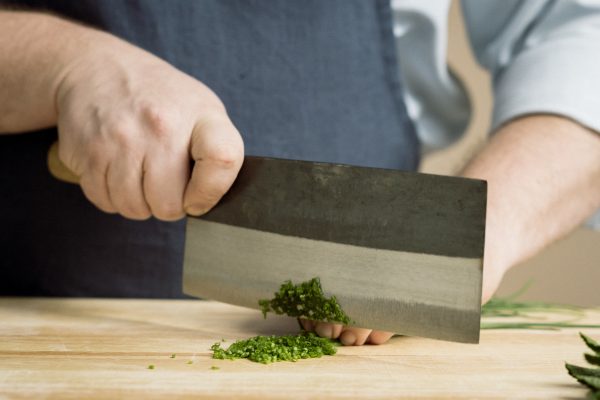
"Cutting herbs was amazing!" commented a home cook who visited Milk Street.
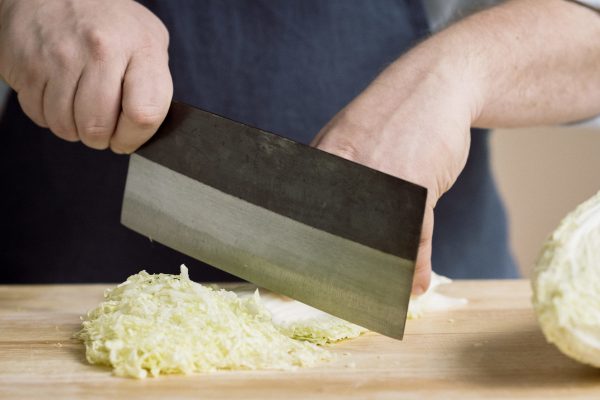
"There's something more satisfying" about chiffonading with a cai dao, one cook said.
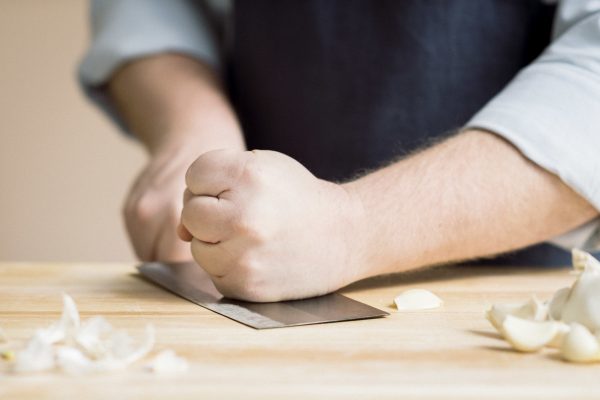
The broad blade of the cai dao made it "easier to smash and, as a result, mince."
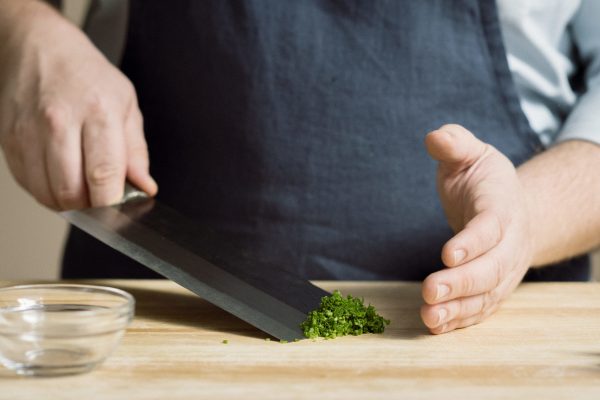
"Having a larger surface to scoop (food) up," one said, "that's a big part of the appeal."
Handling a cai dao in many ways is similar to working with a Western chef’s knife. You should pinch the blade between your thumb and forefinger while the rest of your fingers wrap around the handle. “It should feel pretty sturdy,” says chef Philip Wolfe. “There’s a lot of real estate there, so don’t be afraid to choke up on it.”- Use your other hand to hold an ingredient with a clawed grip, resting your knuckles against the side of the blade, being mindful to keep your thumb behind your knuckles. This position effectively turns the side of the blade into a wall of metal that protects your fingers.
- That large blade has significant weight, so take advantage of it by chopping, not rocking. “Almost all Chinese cooking is done on a forward stroke,” Wolfe says. The rocking motion used with Western chef’s knives often leads cooks to think they’re cutting all the way through herbs or greens, “but they’re actually leaving that bottom leaf or two uncut.” With the Chinese cleaver, “you’re going to feel...that iconic chop, and you should be putting enough force behind it that you notice that.”
- To slice cabbage or greens like Swiss chard, lift your knife off the cutting board between strokes, use a forward motion and keep your knuckles to the blade. “One of the hardest things about learning to use (these knives) is not being afraid to leave the cutting board,” Wolfe says.
- To chop fresh herbs, bunch them tightly together into a bundle, then slice crosswise finely as you would cabbage. For finely minced herbs, bunch the herbs together again and cut crosswise.
- The Chinese cleaver smashes whole garlic cloves more effectively than a Western chef’s knife. You also can slice and smash thin, thumbnail-size pieces—similar to the ginger coins below—for an even finer mince.
- Use the cleaver’s broad surface area as a bench scraper. Carefully scoop up food or waste with the front edge of its blade to transfer it to a bowl, a pan or the trash. Be sure to keep the edge pressed flat against the cutting board.
So is a cai dao for everyone? We invited a host of amateur cooks to Milk Street and put them through an obstacle course of chopping, slicing and smashing. Then we asked them about their experience.
Undeniably, there was a learning curve. Most cooks struggled to stabilize shifty vegetables from above, as I had. Detail work, such as a fine dice or peeling ginger, proved difficult. At the start of the obstacle course, many said the cai dao seemed cumbersome or unwieldy.
But as the course progressed, almost every cook warmed to the knife. By the end, some even stated a preference for the cai dao over the Western-style chef’s knife. Everyone loved the quick work it made of a pile of herbs; there was strong consensus it required less work than they were used to. Chopping onions, carrots and potatoes was comparable to using a Western chef’s knife once the vegetabes were halved. The cai dao’s weight and added leverage made breaking down a tough-skinned butternut or acorn squash much more approachable. And the cooks were most won over by the smash-and-mince technique for garlic and ginger (see sidebar below).
The amateur cooks’ experience with the cai dao followed my own: a conversion from skepticism to appreciation. The effect is to have a bench scraper, meat pounder, food processor and chef’s knife all in one hand. Granted, I can’t use it for all my knifework; I keep my Western chef’s knife on hand for butchery and detail work. But I use the cleaver for much of my everyday knifework. And perhaps one day, with enough practice, I’ll wield one with Fuchsia Dunlop’s confidence.
Numerous companies in China, Japan, Germany and the U.S. manufacture Chinese vegetable cleavers in a range of qualities and prices, from as little as $10 to well over $600. While we don’t suggest going rock-bottom, you don’t need to spend too much more to get a great knife. Slightly higher price points get you knives made from better steel, which hold their edges longer and require less maintenance.
Amateur cooks who visited Milk Street unanimously preferred the Chinese-made CCK Small Cleaver, which sells for about $70. It was the lightest, thinnest cleaver we worked with. The blade has a distal taper (a pronounced thinning to the blade), which contributes to the knife’s nimble handling. And like traditional cai dao, it has a barrel handle.
The CCK’s carbon-steel blade has a kurouchi (or blacksmith’s) finish, giving the blade a slightly coarse, less polished texture than Western chef’s knives. Because the blade is somewhat rough, it creates less surface tension, making it slightly nonstick; ingredients such as squash, garlic and minced herbs were less likely to cling to the side of the blade.
One note: The CCK knife is covered with a thin, protective lacquer before shipping. For best results, light sharpen it before use.
A better way to mince ginger Using the Chinese vegetable cleaver
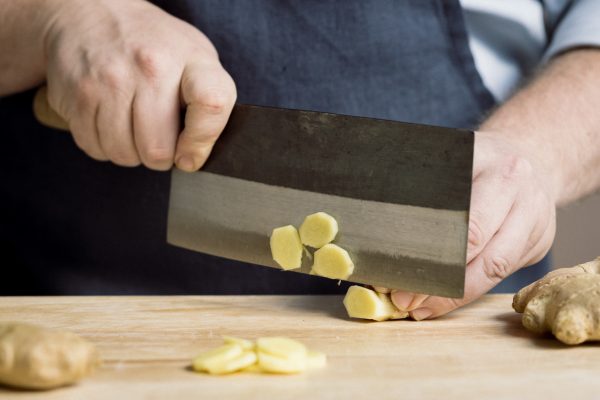
1. Slice the ginger—peeled or unpeeled—into thin coins about the size of your thumbnail, no thicker than ¼ inch. When you smash the ginger, work with one coin at a time.
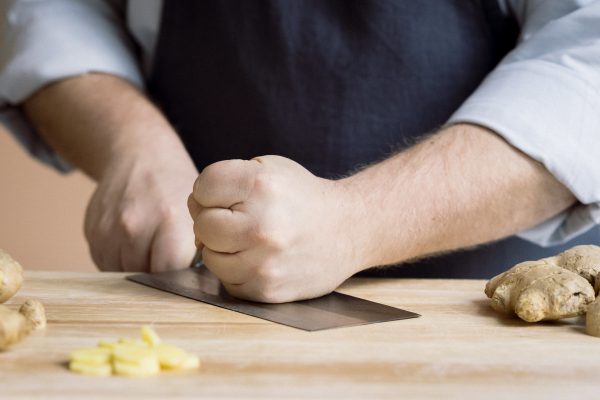
2. Place the flat side of the cleaver’s blade over the coin; the handle of the knife should be off the cutting board so the blade sits perfectly flat. With a balled fist, smash the blade against the board.
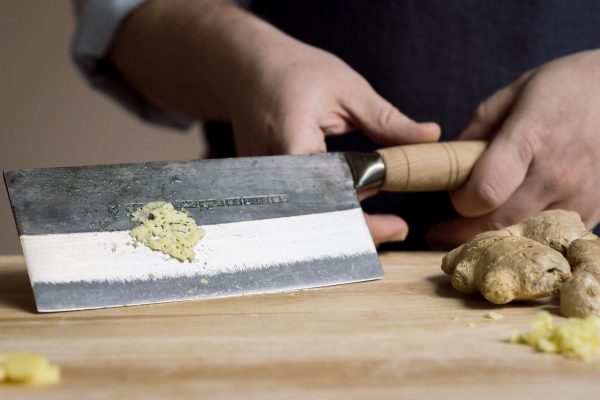
3. Lift your blade. The ginger should be pulverized. If not, try cutting thinner coins or whacking the flat side of the blade more forcefully when you smash.
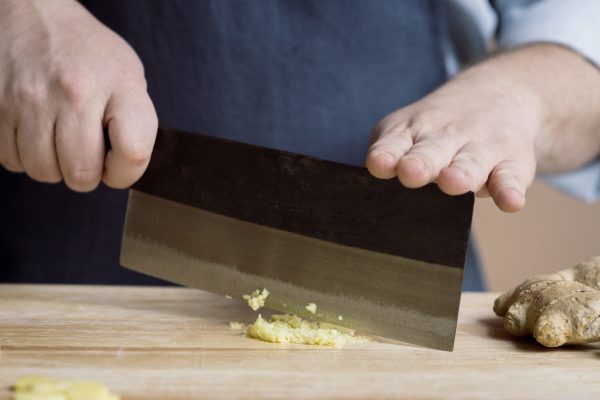
4. Chop your knife through the pulverized ginger to finely mince it. Home cooks loved this technique: “That’s the best I’ve minced my ginger—probably ever,” one commented.
When we use fresh ginger at Milk Street, we typically reach for a wand-style grater. It’s the fastest, most efficient way we know for breaking down the fibrous plant. But a simple trick we learned from chef Philip Wolfe makes mincing ginger easier and faster than ever.


